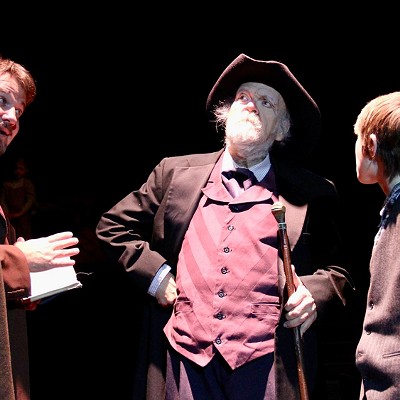Two features of the street creating discussion are a western portion that will be above grade at the level of the old I-40 and a section that will go under the north-south railway.
A third issue, however, has received little public attention: the undecided route to Bricktown from the future major thoroughfare.
Although current maps distributed by ODOT show direct access to Bricktown would be created by extending Oklahoma Avenue south to intersect the boulevard, no final decision has been reached. That plan would necessitate the city purchasing the right of way from the owner of the downtown U-Haul building on Oklahoma.
Instead, the city is considering another options, too, said city Public Works Director Eric Wenger: build the intersection at Compress Avenue, which would create indirect access to Bricktown.
“The one at Oklahoma [Avenue] is just a conceptual thing,” said ODOT engineer Paul Green, who gave the updates to the MAPS 3 committee and subcommittees. “The city is looking at that, actually. … The city does not own the street right of way to connect through there.”
Green said Compress Street is not the preferred alignment, but not owning the right of way for Oklahoma Avenue complicates the matter.
“The city is exploring their options,” Green said. “[ODOT’s] objective is to build within our right of way. Now if the city has other wishes, we will certainly try to accommodate those.”
Wenger said no decision has been made on the route, so property owners have not been contacted. The boulevard’s anticipated completion is in two years.
“We wouldn’t make contact until a decision was made and we’re still off a little ways,” he said.
He said the Oklahoma Avenue option is favored, but it would require more time and funding, whereas the Compress Street option would not be as expensive and time-consuming since there is an existing street.
A decision likely will be made within the next six to eight weeks, Wenger said.
Room to grow
Green told the subcommittees that ODOT planned to bring the boulevard further south of the future convention center to give the building more room, and that the street would go below grade east of S. E.K. Gaylord Boulevard to allow streetcar and vehicular traffic to travel under the railway.
Transit subcommittee members and Ward 2 Councilman Ed Shadid expressed concern that ODOT was not working closely enough with the subcommittee or taking into account the new preferred streetcar route, which calls for double track lanes on the boulevard.
Having the streetcar on the boulevard would require zones with no utility lines. Moreover, the Intermodal Transit Hub study called for the boulevard to remain below grade after passing under the railway, allowing for potential high speed and commuter rail.
Wenger said ODOT is consulting with the city on all these issues.

“There’s a lot of planning we can do with ODOT at this point, making sure we don’t put ourselves in a corner,” he told the council at its May 29 meeting. “But at the same time, we’ve got to wait for some of the other consulting to occur so we know what we’re going to construct.”
Making the grade
The plans also call for the boulevard to go above grade to pass over the complicated intersection of Reno, Classen and Western, a concept that concerned Shadid and Ward 4 Councilman Pete White, both in terms of slowing traffic and allowing for development along the street.
“We’re not trying to do what ODOT traditionally tries to do. We’re not trying to move as many cars along that area as fast as we can. That’s not the purpose; the purpose is exactly the opposite of that,” White said.
“If you build it like an interstate highway, even if you only build it a couple hundred yards that way, you’ve defeated the whole purpose of why we’re doing this, why we wanted a boulevard.”
Mayor Mick Cornett said he has known for several years that the boulevard would have to go above grade near that intersection, and that it would help concentrate development.
“I know it’s not necessarily been communicated throughout the community because not everybody cares that much about a road that’s several years away,” Cornett said.
Wenger said keeping the boulevard at grade through that intersection would be nearly impossible. The city and ODOT, he said, are reviewing options of whether to build the above-grade section on columns or on an earthen ramp.
“There is a portion of the boulevard that will go over the top of those roads,” Wenger said. “I think maybe that surprised some on [May 29], but it has been that way for sometime.”











